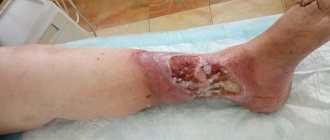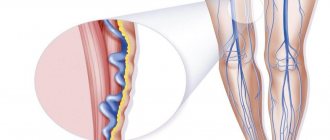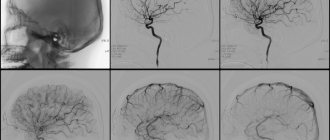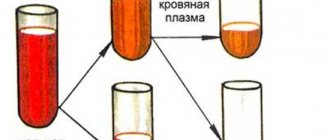Publications in the media
Superficial thrombophlebitis is an inflammatory disease characterized by the development of thrombosis and reactive spasm of the superficial veins, most often of the lower extremities. Often develops as a complication of varicose veins. Iatrogenic thrombophlebitis of the superficial veins sometimes occurs after venipuncture or venosection.
Localization . The great saphenous vein and its tributaries are most often affected in the upper third of the leg, lower and middle thirds of the thigh. Rare forms: thrombophlebitis of the superficial veins of the mammary gland and anterior chest wall (Mondor's disease), as well as thrombophlebitis of the dorsal vein of the penis.
Classification . Acute, subacute, recurrent; migratory thrombophlebitis (repeated thrombosis of various parts of the superficial veins, most often in the lower extremities); ascending and descending.
Etiology . Phlebitis can develop independently and cause venous thrombosis, or the infection quickly joins the primary thrombosis of the superficial veins. In addition, it can be secondary to vasculitis, for example, periarteritis nodosa and thromboangiitis obliterans (Buerger's disease). Migratory thrombophlebitis can be a marker of carcinoma, most often of the tail of the pancreas. Thrombophlebitis of the dorsal penile vein is usually caused by acute or chronic trauma.
Pathogenesis . Thrombophlebitis develops in the presence of the following conditions: slow blood flow, increased blood clotting, damage to the wall or valves of the veins, and infection.
Clinical picture • Acute thrombophlebitis occurs suddenly, accompanied by an increase in body temperature followed by chills. Along the course of the affected vein, a painful dense infiltrate in the form of a cord is palpated. Over the infiltrate, hyperemia of the skin with compaction of the subcutaneous tissue is possible. Regional lymph nodes are enlarged • The subacute form of thrombophlebitis occurs without acute local inflammatory phenomena, with normal or slightly elevated body temperature in the first days. When walking, moderate pain, general malaise • The recurrent form is characterized by the emergence of a new area of damage to the superficial veins or exacerbation of a previously occurring process • With Mondor's disease, thrombophlebitis is usually localized in the upper anterolateral part of the mammary gland, or spreads from the lower part of the gland through the submammary fold towards costal arch and epigastrium.
Laboratory tests • Leukocytosis with a shift of the leukocyte formula to the left and increased ESR • PTI • Duplex ultrasound scanning can confirm the spread of a blood clot to the deep veins of the limb • With migratory thrombophlebitis, a thorough examination of the digestive organs is necessary to exclude a primary oncological disease. In diagnostically unclear cases, it is recommended to determine the content of CEAg in the blood serum.
Differential diagnosis • Erysipelas • Lymphangitis • Cellulitis • Tendonitis • Rupture of the medial head of m. gastrocnemius.
TREATMENT
Conservative treatment • Bed rest, elevated position of the limb • Elastic bandage helps fix the blood clot in the superficial veins • Locally: compress with Vishnevsky ointment, semi-alcohol compress, heat • Physiotherapy: iontophoresis with thrombolytin (trypsin-heparin complex) • Drug treatment •• Anti-inflammatory therapy: acetylsalicylic acid, NSAIDs (reopyrin, phenylbutazone). Anticoagulants are usually not prescribed, except in cases of spread of the process to the deep venous system •• Recurrent superficial thrombophlebitis - antibiotics •• Acetylsalicylic acid as a weak anticoagulant •• Troxerutin 0.3–0.6 g/day for 2–4 weeks.
Surgical treatment . The Troyanov–Trendelenburg operation is performed in the presence of a blood clot at the mouth of the great saphenous vein (the blood clot is removed).
Complications • Hyperpigmentation of the skin over the affected vein. • Organized thrombus fixed inside a varicose vein. • Thrombophlebitis of deep veins. About 12% of patients with thrombophlebitis of the great saphenous vein above the level of the knee have spread of the thrombus to the deep veins of the limb (through perforating veins or saphenofemoral anastomosis). • PE • Suppurative phlebitis may be complicated by metastatic abscesses or septicemia • Streptococcal lymphangitis
The prognosis is favorable with timely and adequate appropriate treatment. The patient should be informed that the illness may last 3–4 weeks or longer. With varicose veins of the superficial veins of the lower limb, the likelihood of relapse is very high. To prevent it, phlebectomy is recommended.
Synonym . Thrombophlebitis of superficial veins
ICD-10 • I80 Phlebitis and thrombophlebitis
APPLICATIONS
Thrombosis of the superior sagittal sinus is a blockage of the superior sagittal sinus, the only sinus that carries out venous outflow from the dura mater, with a thrombus. Causes : infection, complication of osteomyelitis, dehydration, trauma, tumors. Clinical picture : fever, headache, lethargy, stretching of the veins of the scalp, convulsions, aphasia, hemiplegia; usually occurs acutely. Treatment depends on the cause: antimicrobials, drainage, surgery. Synonym : thrombosis of the superior longitudinal sinus. ICD-10 . G08 Intracranial and intravertebral phlebitis and thrombophlebitis.
Cavernous sinus thrombosis is a disease characterized by infection of the venous canals that carry out venous drainage from the face and orbit. Causes : direct penetration of infection from the eye socket and face. Risk factors : diabetes and immunodeficiency states. Clinical picture : exophthalmos, swelling of the optic nerve nipple, headache, convulsions, septic fever. The prognosis is unfavorable. Treatment : Hospitalization, intensive care, intravenous fluids and antibiotics. Synonym : cavernous sinus syndrome. ICD-10 . G08 Intracranial and intravertebral phlebitis and thrombophlebitis.
Renal vein thrombosis . Causes : abdominal surgery, chronic heart failure, dehydration, kidney disease, decreased renal blood flow. Clinical picture : lumbar pain, dysuria, enlarged painful kidney. The course can be acute or chronic. Treatment : anticoagulants, glucocorticoids. ICD-10 . N28 . 0 Renal ischemia or infarction.
Factors of occurrence
The causes that provoke the development of the disease (ICD code 10 I 80) are divided into 3 factors:
- Thickening of the blood due to changes in its composition.
- Reducing the speed of blood flow.
- Damage to the inner lining of blood vessels.
These factors are diagnosed individually or in combination. They contribute to the development of varicose veins, which is the cause of acute thrombophlebitis.
Vein thrombosis is a rather dangerous disease that can be fatal if a blood clot breaks off and enters the arteries of the lung or heart.
Thrombophlebitis (ICD code 10 I80) develops with forced immobility of a limb (with a fracture).
Thrombosis of the veins of the lower extremities is caused by taking estrogen-containing hormones prescribed for infectious and autoimmune diseases. Oncological diseases provoke thrombophlebitis of the lower extremities. Installation and long-term presence of a catheter in the venous bed and frequent injury to the walls by injections lead to the formation of blood clots.
In 65% of cases, thrombophlebitis is diagnosed in women. The pattern is associated with wearing high-heeled shoes, tight jeans and taking hormonal contraceptives. The cause of the disease may be pregnancy. During this period, physiological activation of coagulation processes occurs, preventing bleeding in the postpartum period, and the inflamed vessel wall leads to the formation of a blood clot. People aged 40-55 years are at risk. At this age, the condition of the body's vascular system deteriorates significantly.
Thrombosis is hereditary. Causative factors include obesity, unbalanced diet, physical activity, smoking and drinking alcoholic beverages.
Deep vein thrombosis has a specific code in the ICD-10 classification – I80
Symptoms
Thrombosis of the lower extremities according to the clinical picture is classified into:
- Spicy. Symptoms of the acute form appear suddenly. The patient experiences muscle pain along the thrombosed vessel. Acute thrombosis is accompanied by elevated body temperature. Red stripes appear on the skin. Deep vein thrombophlebitis differs from superficial thrombophlebitis in severe swelling, heaviness in the legs and bluish skin. The pain intensifies, causing lameness.
- Chronic. With this form, blood clots may dissolve or enlarge. Chronic deep vein thrombophlebitis has a sluggish nature. The patient may experience pain only upon palpation.
The main factors that can provoke deep vein thrombophlebitis are: tissue nutritional disorders and the development of aseptic inflammation
When the inferior vena cava is blocked, bilateral swelling of the limb is observed. If the thrombus is located in the iliac segment, then unilateral edema is noted. When walking for a long time, aching pain appears in the calf muscle.
Thrombosis is manifested by numbness of the limbs, loss of sensitivity, tingling of the skin, chills and hardening of the lymph nodes. The first symptoms of the chronic form may appear a year after the exacerbation. The disease can be migratory in nature. This form is characterized by rapid development. The migratory form affects the superficial veins. Dense thrombosed nodules can change their position, appearing in different parts of the limb. Seals are accompanied by swelling and increased body temperature.
Classification of the disease
ICD 10 code I80 includes phlebitis and thrombophlebitis. Symptoms vary depending on the location of the clot. There are 2 types of diseases:
- surface;
- deep.
Superficial thrombophlebitis develops in the great saphenous vein. It is easy to diagnose. Inflammatory changes occur in the area of the affected vessel, but if varicose veins are not observed, then thrombophlebitis is interpreted by ICD 10 as a complication of gynecological pathology or a symptom of a malignant tumor in the organs of the digestive system. Thrombophlebitis ICD 10 also includes thrombosis in the intestine.
When palpating the inflamed saphenous vein, the patient experiences stabbing pain. Symptoms of superficial thrombophlebitis: scarlet stripes on the skin, swelling of the ankles and feet, increased body temperature.
Without treatment, thrombosis spreads to the deep veins. The patient's health worsens. Infiltration and hyperemia are observed in the area of the thrombosed vessel.
There are 2 types of thrombosis that require special attention:
- Ileofemoral thrombosis is a subtype of deep vein thrombophlebitis. The disease affects large vessels in the femoral and iliac veins. If blocked, it can be fatal. Ileofemoral thrombosis develops rapidly. The patient develops severe swelling of the lower extremities. High body temperature is added to the symptoms. The skin acquires a bluish tint. Complete blockage can lead to the development of gangrene.
Such an acute inflammatory process of the lower extremities is dangerous for human life, and ignoring it can lead to death
- Mesenteric vascular thrombosis is a blockage of the mesentery or mesentery. Without treatment, thrombosis of the mesenteric vessels leads to the death of the affected area. Mesenteric thrombosis (code K55 in ICD 10) requires immediate surgical intervention.











